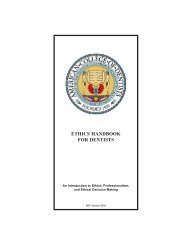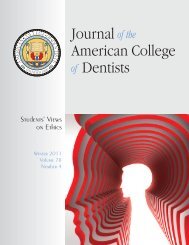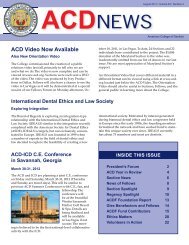JACD 71-4 - American College of Dentists
JACD 71-4 - American College of Dentists
JACD 71-4 - American College of Dentists
- No tags were found...
Create successful ePaper yourself
Turn your PDF publications into a flip-book with our unique Google optimized e-Paper software.
Cohesive gold became available. Amalgam<br />
started to be developed. What is now the<br />
<strong>American</strong> Dental Association was started<br />
in the 1850s. There were other dental<br />
education programs beginning, but most<br />
<strong>of</strong> the education in the U.S. in the 1800s<br />
was still by apprenticeship. There was<br />
no scientific approach to operative<br />
procedures or restorative materials. The<br />
first dental school in a university was<br />
founded at Harvard University.<br />
G. V. Black<br />
The first case study in audacious leadership<br />
I will present is someone whom all<br />
<strong>of</strong> us in dentistry know—Dr. G. V. Black,<br />
a dentist-physician who began as an<br />
apprentice dentist in the late 1800s but<br />
laid the foundations for dentistry as a<br />
pr<strong>of</strong>ession. He was recognized as an<br />
inquisitive man, a person who was interested<br />
in creating a scientific approach to<br />
his pr<strong>of</strong>ession. He joined the Chicago<br />
<strong>College</strong> <strong>of</strong> Dental Surgery in 1883 on a<br />
full-time basis and began to develop an<br />
understanding <strong>of</strong> operative dentistry. He<br />
became dean <strong>of</strong> Northwestern University<br />
School <strong>of</strong> Dentistry and served from<br />
1897 until 1915. During that time, he<br />
refined dental amalgam as a cost-effective<br />
alternative to extraction or gold. His<br />
published work on operative dentistry<br />
in 1908 was essentially the textbook <strong>of</strong><br />
operative dentistry for more than fifty<br />
years. To better understand restorative<br />
treatment he probed the etiology <strong>of</strong> the<br />
dental caries. He worked with others in<br />
helping define what we now know as<br />
the plaque concept and the biochemical<br />
changes that subsequently occur in the<br />
caries process. G. V. Black was recognized<br />
within the pr<strong>of</strong>ession <strong>of</strong> his time<br />
as an audacious leader. His leadership<br />
resulted in major changes; he redefined<br />
dentistry as a pr<strong>of</strong>ession and not a trade.<br />
William J. Gies<br />
Journal <strong>of</strong> the <strong>American</strong> <strong>College</strong> <strong>of</strong> <strong>Dentists</strong><br />
The needs <strong>of</strong> the<br />
practicing pr<strong>of</strong>ession<br />
have outgrown the<br />
capacity <strong>of</strong> our<br />
educational programs.<br />
The dental pr<strong>of</strong>ession faced new<br />
challenges at the turn <strong>of</strong> last century.<br />
Dental education was still principally<br />
provided in proprietary schools—<br />
essentially a grouped and economically<br />
superior form <strong>of</strong> apprenticeship. Dental<br />
students had little or no exposure to<br />
basic and clinical sciences or anything<br />
else that was not directly billable. Their<br />
education was primarily focused on<br />
cavity preparation and restoration,<br />
placement <strong>of</strong> dentures, and extractions.<br />
(Remember, it was also at this time<br />
that vulcanite was invented, and it<br />
was becoming a readily available and<br />
worthwhile material to use as a base<br />
for complete dentures.) Essentially no<br />
scientific research was being conducted<br />
in dentistry.<br />
The times were right for another<br />
audacious leader, William J. Gies.<br />
Gies was not a dentist; he was a PhD<br />
biochemist who taught at Columbia<br />
University in New York. Local dentists<br />
stimulated his interest in developing a<br />
scientific foundation for practice. He<br />
was one <strong>of</strong> the founders, in 1916, <strong>of</strong> the<br />
Columbia University School <strong>of</strong> Dental &<br />
Oral Surgery. He was the founding editor<br />
<strong>of</strong> the Journal <strong>of</strong> Dental Research in 1919<br />
and continued in that capacity into the<br />
mid-1930s. He was one <strong>of</strong> the founders<br />
in 1923 <strong>of</strong> both the International<br />
Association for Dental Research and the<br />
<strong>American</strong> Association <strong>of</strong> Dental Schools,<br />
now the <strong>American</strong> Dental Education<br />
Association. But perhaps he is best<br />
known for the “Gies Report,” released in<br />
1926. Abraham Flexner, an educator, had<br />
been hired by the Carnegie Foundation<br />
in the early 1900s to evaluate medical<br />
education in the United States. The<br />
National Leadership Symposium<br />
result <strong>of</strong> that report was a recommendation<br />
that medical education should<br />
include basic, clinical, and behavioral<br />
sciences and two years <strong>of</strong> clinical<br />
experience. Gies was also hired by the<br />
Carnegie Foundation to undertake a<br />
similar comprehensive investigation in<br />
dentistry. He visited every dental school<br />
in the United States and Canada. His<br />
report to the Carnegie Foundation<br />
essentially paralleled Flexner’s work,<br />
arguing for a three-year curriculum, an<br />
increase in research, and strengthening<br />
the foundations <strong>of</strong> pr<strong>of</strong>essional education<br />
so that dentistry, although a distinct pr<strong>of</strong>ession,<br />
would be the equal <strong>of</strong> medicine.<br />
Gies had the audacity to make recommendations<br />
to provide leadership and<br />
again was very well recognized within<br />
our pr<strong>of</strong>ession during his time.<br />
Arthur A. Dugoni<br />
Now let’s move to the middle and late<br />
1900s. What were some <strong>of</strong> the challenges<br />
facing dental educators at the end <strong>of</strong> the<br />
last century? Our pr<strong>of</strong>ession was polarized<br />
in the 1960s through the 1990s and<br />
there was dissatisfaction among people<br />
attempting to work together. Another<br />
feature <strong>of</strong> our pr<strong>of</strong>ession at this time was<br />
that teaching methods in dental school<br />
during this time were <strong>of</strong>ten militaristic<br />
or draconian. In my dental school<br />
experience, we did not refer to faculty<br />
members as “doctor,” but by their<br />
military rank. Still another feature <strong>of</strong> our<br />
pr<strong>of</strong>ession at this time was curriculum<br />
overload. We added content to an<br />
already heavily loaded program, and<br />
there were concerns about the relevance<br />
<strong>of</strong> certain portions <strong>of</strong> the curriculum.<br />
There were new procedures and new<br />
biomedical knowledge, and patients<br />
were become more complex. The needs <strong>of</strong><br />
51





